Reflective practice
Reflective practice is a learning strategy that promotes metacognition and develops students’ capacity for self-regulation.
What is it?
Reflective practice is a learner-centred strategy that helps students to make sense of what they are learning and engages them in deep learning. Reflection can be in-action and on-action:
- Reflection-in-action takes place while students are engaged in a practical activity and requires them to act on their reflection immediately
- Reflection-on-action invites students to reconsider and clarify a past event (for example a site visit, an in-class activity, or a practicum).
Students can also reflect on their prior knowledge to prepare for a ‘core’ activity. Reflection tasks encourage students to take a step back, observe, and evaluate their actions to either problem solve or gain a new perspective. Reflection works best when it is regular, scaffolded, and progressively develops in complexity. Through regular reflection, students engage in metacognition and become self-regulated learners.
Why is it useful?
Benefits for students
- Assesses functioning knowledge, including application of skills and competencies
- Prompts metacognition, which, in turn, encourages students to take responsibility for their own learning
- Develops evaluative judgment through metacognition and analysis of their own thought process
- Promotes the development of professional identity through a reflection on a work placement or a practice simulation.
Benefits for educators
- Gives you access to the thought process of your students, which, in turn, facilitates an effective feedback loop.
How do I implement it?
To implement reflective practice, try these strategies:
- Set a model for students’ reflections. This will prompt students what to include and give you a clear framework to assess the reflection. It will also help students who are less familiar with reflective tasks and unsure where to start. You can use one of the established reflection models:
-
Driscoll’s Model of Reflection
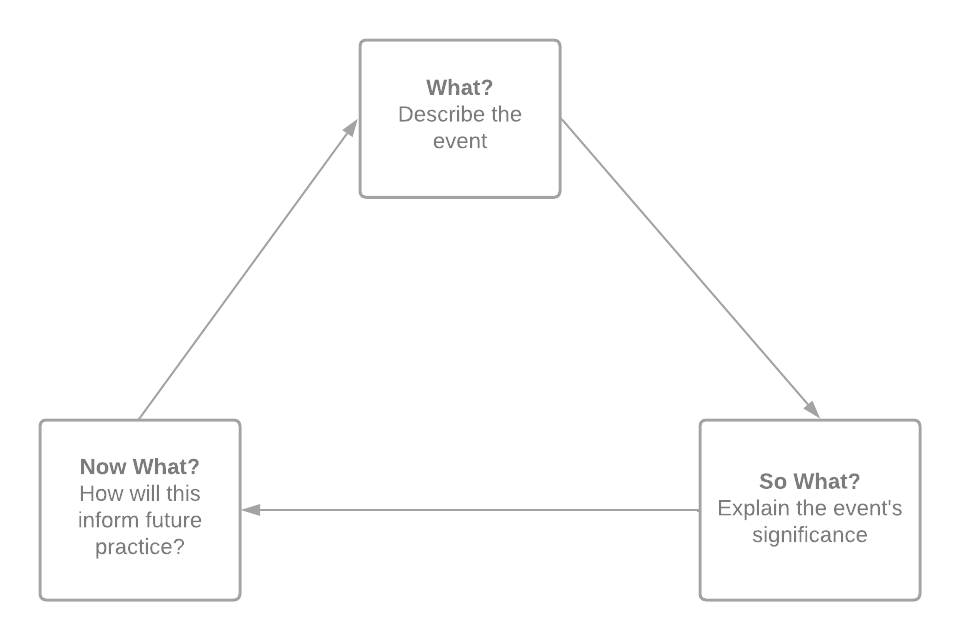
What… So what… Now what… Questions to help with the description of the event/experience Questions to help with the understanding of the event/experience Questions to help with what can be done to improve the experience …is the problem? or
…is the reason for this difficulty?
…does this tell me about me about:
- me?
- my patient/student?
- others?
- our relationship?
- my patient’s care?
- the model of care/teaching approach I am using?
- my attitudes?
- my patient’s/student’s attitudes?
…do I need to do in order to:
- make things better?
- stop being stuck?
- improve my patient’s care?
- resolve the situation?
- feel better?
- get on better?
…was my role in this situation?
…was going through my mind as I acted?
…broader issues need to be considered if this action is to be successful?
…was I trying to achieve?
…did I base my actions on?
…might be the consequences of this action?
…actions did I take?
…other knowledge can I bring to the situation?
- experience
- personal
- scientific
…was the response of others?
…could I have done to make it better?
…were the consequences?
- for the patient/student?
- for myself?
- for others?
…is my new understanding of the situation?
…feelings did it evoke?
- in the patient/student?
- in myself?
- in others?
…broader issues arise from the situation?
…was good (or bad) about the incidence or experience?
Driscoll, J.J. (2007) Supported reflective learning: the essence of clinical supervision? Chapter 2 in Practising Clinical Supervision: A Reflective Approach for Healthcare Professionals (2nd edition). London: Bailliere Tindall. pp 27-‐50.
-
Kolb's Experiential Learning Cycle
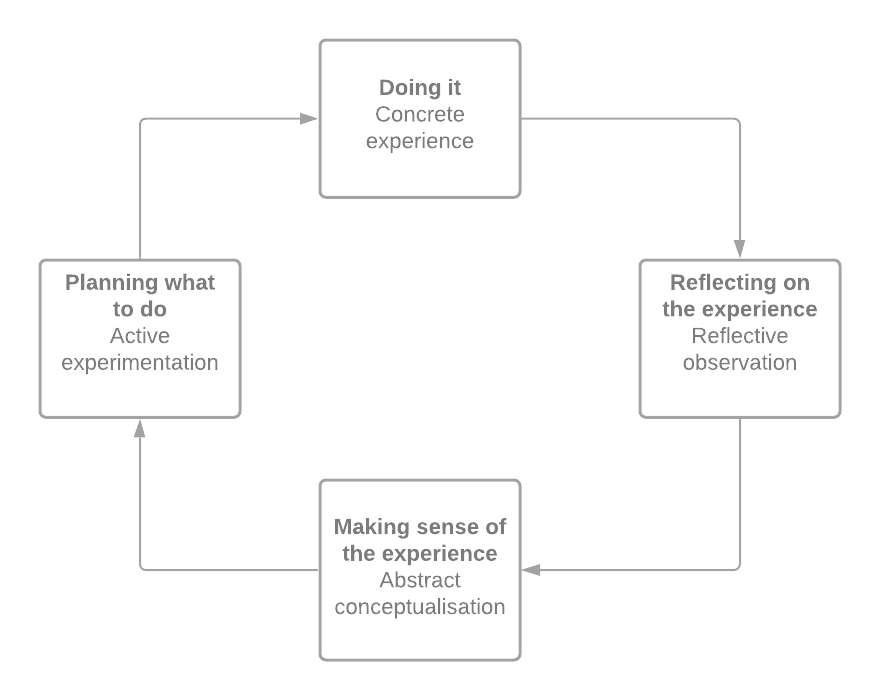
Example question prompts
Doing it
What happened?
- What did you do? Where did it happen? Who was involved? What was the context?
Reflecting on the experience
What were you thinking and feeling?
- Describe your internal thoughts and feelings before, during and after the event
Making sense of the experience
What was good and bad about the experience?
- Were there things that were difficult? Interesting? Surprising? Upsetting? Provide some judgement about the event and its possible consequences
Planning what to do
- What would you do if a similar situation arose again?
- What are some indicators that would help you recognise a similar event?
- What are some changes you would make?
Kolb DA. Experiential learning: experience as the source of learning and development. Englewoods Cliffs, N.J.: Prentice Hall, 1984.
-
Johns' Model of Reflection
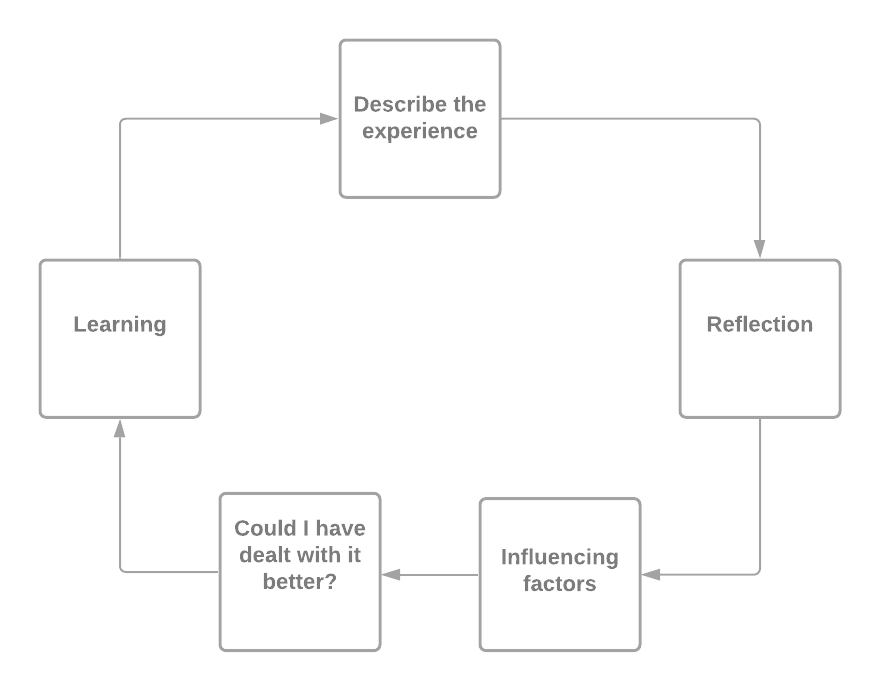
Example question prompts
Describe the experience - Describe the experience, and the significant factors that were involved?
Reflection - What was I trying to achieve?
- What were the consequences of my actions?
- How did I feel about this experience when it was happening? Why did I feel this way?
- If there was another person involved (e.g., a patient), how did they feel about the situation?
Influencing factors - What things (e.g., internal factors, my own knowledge, external factors) affected my decision making and actions?
Could I have dealt with it better? - What other choices did I have?
- Did I act for the best?
- What would the consequences of those other actions have been? For myself? For others?
Learning - What will change because of this experience?
- How do I now feel about the experience?
- How has this experience changed my ways of knowing?
- Empirics (scientific)
- Ethics (moral knowledge)
- Personal (self-awareness, e.g., of my own beliefs and values)
- Aesthetics (the art of what we do, our own experiences)
Johns C. Becoming a reflective practitioner: a reflective and holistic approach to clinical nursing practice, development and clinical supervision. Oxford: Blackwell Science, 2000.
-
Atkins and Murphy’s Model of Reflection
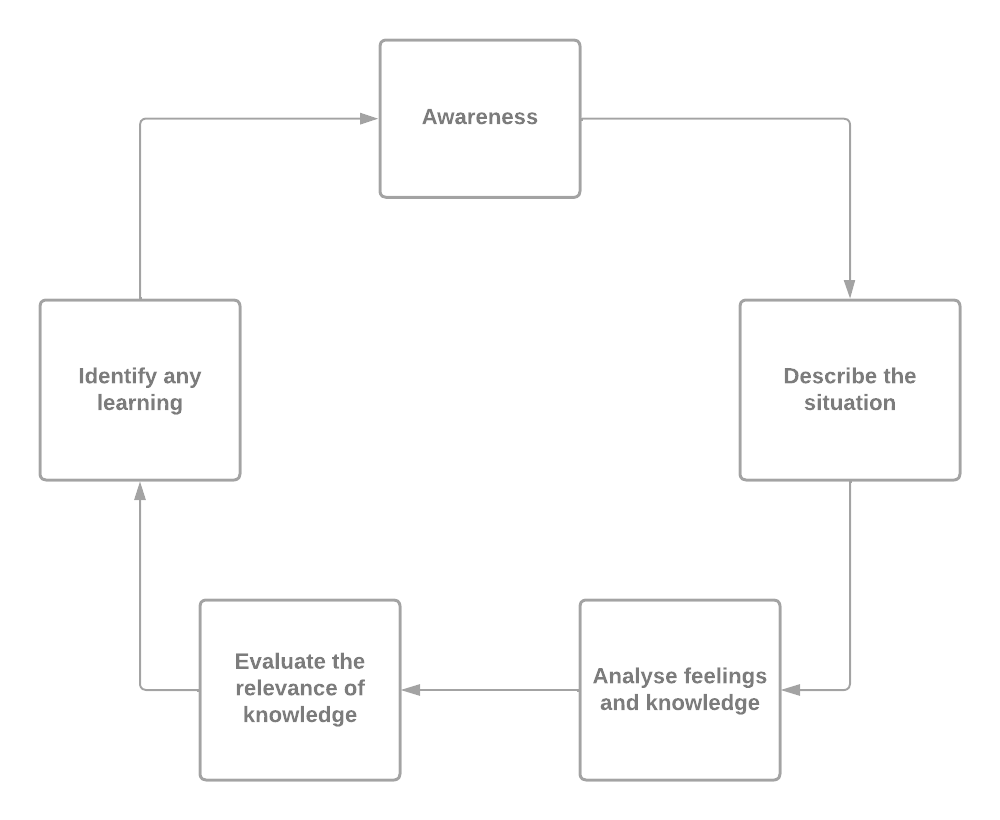
Example question prompts
Awareness
- What happened?
- What influenced my emotions?
- What were my emotions after the situation occurred?
- What was I thinking?
- What am I now thinking looking back at the situation?
Describe the situation
- What was the event?
- Where was the event?
- When did it happen?
- What was my involvement during the event?
- What did other people do?
- What were the key observations?
Analyse feelings and knowledge
- Imagine and explore alternatives
- What did I already know about the situation?
- What were my assumptions about the situation?
- How did reality reflect my assumptions?
- What were the differences?
- How would I react if something else happened?
- In what type of scenarios would the discomfort not occur?
Evaluate the relevance of knowledge
- How does it help to explain the situation?
- How does analyzing different scenarios influence your thoughts?
- How complete was your use of knowledge?
- How can your knowledge next time be useful?
Identify any learning
- What have I learned?
- How can my learnings be used in future situations?
Atkins, S. and Murphy, K. (1994). Reflective Practice. Nursing Standard, 8(39) 49-56.
-
Gibbs' Reflective Cycle
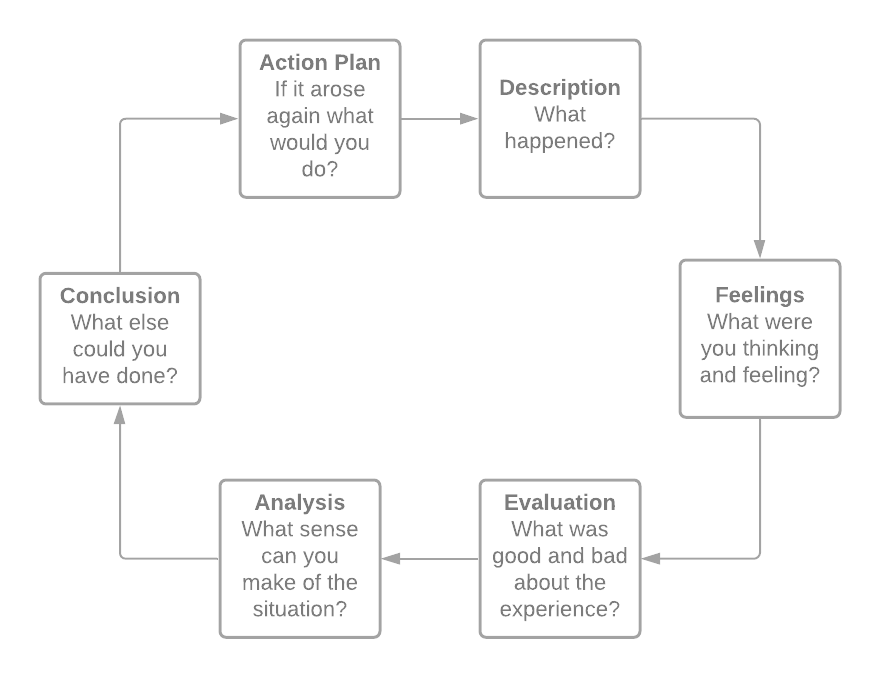
Example question prompts
Description (of the event) What happened?
- What did you do? Where did it happen? Who was involved? What was the context?
Feelings What were you thinking and feeling?
- Describe your internal thoughts and feelings before, during and after the event
Evaluation What was good and bad about the experience?
- Were there things that were difficult? Interesting? Surprising? Upsetting? Provide some judgement about the event and its possible consequences
Analysis What sense can you make of the situation?
- How do past experiences compare to this?
- How does theory or evidence fit with this?
- How did your involvement affect the outcome?
Conclusion What else could you have done?
- What insights, thoughts, or conclusions, about your role within this event that you can now take away?
- What have you learnt for the future?
Action plan What would you do if a similar situation arose again?
- What are some indicators that would help you recognise a similar event?
- What are some changes you would make?
Whatever model you choose, make sure it is aligned with the task at hand and the intended learning outcomes.
- Engage students in regular reflective practice through blogging or journaling. Based on your subject, students can reflect on weekly readings, practice sessions, site visits, scenario-based group activities or work placements. When setting a continuous reflective task, be clear why you are asking students to reflect and how they will be assessed.
- Integrate reflection in regular learning activities. Give students opportunities to reflect in class. To make this work, it is important to consider reflection when planning a learning activity. For example, if students are working in small groups on a structured case analysis, you can pause the activity at different stages and prompt students to reflect in action and act on their reflection upon returning to the activity. Alternatively, you can use one of the reflection models (outlined above) to prompt a reflection-on-action at the end of the group activity. These strategies can be used with other types of synchronous and asynchronous learning activities. What’s important is to allocate sufficient time for reflection so that students can fully engage in a reflective cycle and reflect on what happened, why it was important, and how they will apply this in future.
Supporting technologies
- Cadmus is an online assessment environment that offers assessment templates for the most common written assignment types, including a reflective journal and a reflective essay. The templates for reflective assessment provide checklists for students to guide them through the reflection process and keep them on track. In addition, Cadmus allows submission of assignment drafts, which you can then use to provide cohort-level feedback.
- PebblePad is an ePortfolio platform – a space for students to blog, journal, and showcase their project work. PebblePad can integrate reflection and self-assessment into digital portfolios.
- LMS Discussions can facilitate blogging. Students can both respond to a reflection prompt and interact with their peers’ responses. This deepens students’ reflection and supports a provision of formative peer feedback.
- H5P allows you to create interactive activities and embed them into the LMS. The Documentation tool in H5P allows you to embed reflection boxes on the LMS pages and prompt students to reflect with structured questions in line with your chosen reflection model. Once students enter their reflection into the text box, they can then generate a downloadable document with their responses.
- FeedbackFruits allows you integrate reflection into peer review, self-assessment and social annotation tasks. You can make this a structured reflection by adding instructions and structured questions for students to reflect on.
- LMS Quizzes can facilitate structured reflection exercises. You can use the essay question type to ask students structured reflection questions in line with one of the reflection models (presented above). Students’ access and completion of quizzes can be monitored via New Analytics.
Resources
- Academic Skills, University of Melbourne. Reflective writing.
- Biggs, J., & Tang, C. (2011). ‘Assessing and grading for functioning intended learning outcomes’ in Teaching for quality learning at university. McGraw-Hill Education.
- Instructure Community. How do I create a quiz with individual questions?
- Learning Environments, University of Melbourne. Designing reflection activities.
- Learning Management System, University of Melbourne. FeedbackFruits.
This page was last updated on 11 Apr 2024.
Please report any errors on this page to our website maintainers